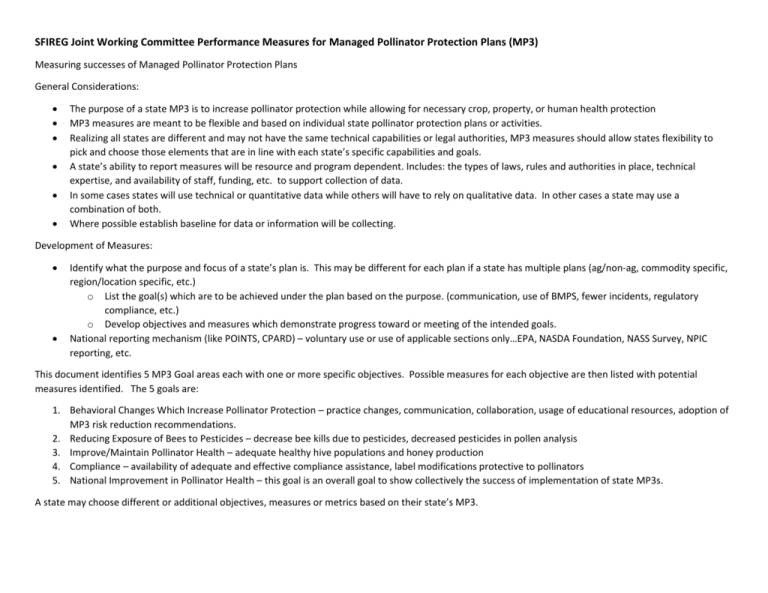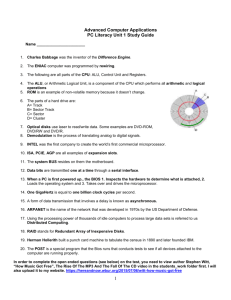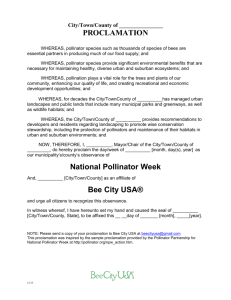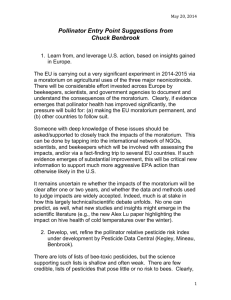SFIREG Joint Working Committee Performance Measures for
advertisement

SFIREG Joint Working Committee Performance Measures for Managed Pollinator Protection Plans (MP3) Measuring successes of Managed Pollinator Protection Plans General Considerations: The purpose of a state MP3 is to increase pollinator protection while allowing for necessary crop, property, or human health protection MP3 measures are meant to be flexible and based on individual state pollinator protection plans or activities. Realizing all states are different and may not have the same technical capabilities or legal authorities, MP3 measures should allow states flexibility to pick and choose those elements that are in line with each state’s specific capabilities and goals. A state’s ability to report measures will be resource and program dependent. Includes: the types of laws, rules and authorities in place, technical expertise, and availability of staff, funding, etc. to support collection of data. In some cases states will use technical or quantitative data while others will have to rely on qualitative data. In other cases a state may use a combination of both. Where possible establish baseline for data or information will be collecting. Development of Measures: Identify what the purpose and focus of a state’s plan is. This may be different for each plan if a state has multiple plans (ag/non-ag, commodity specific, region/location specific, etc.) o List the goal(s) which are to be achieved under the plan based on the purpose. (communication, use of BMPS, fewer incidents, regulatory compliance, etc.) o Develop objectives and measures which demonstrate progress toward or meeting of the intended goals. National reporting mechanism (like POINTS, CPARD) – voluntary use or use of applicable sections only…EPA, NASDA Foundation, NASS Survey, NPIC reporting, etc. This document identifies 5 MP3 Goal areas each with one or more specific objectives. Possible measures for each objective are then listed with potential measures identified. The 5 goals are: 1. Behavioral Changes Which Increase Pollinator Protection – practice changes, communication, collaboration, usage of educational resources, adoption of MP3 risk reduction recommendations. 2. Reducing Exposure of Bees to Pesticides – decrease bee kills due to pesticides, decreased pesticides in pollen analysis 3. Improve/Maintain Pollinator Health – adequate healthy hive populations and honey production 4. Compliance – availability of adequate and effective compliance assistance, label modifications protective to pollinators 5. National Improvement in Pollinator Health – this goal is an overall goal to show collectively the success of implementation of state MP3s. A state may choose different or additional objectives, measures or metrics based on their state’s MP3. Goal of MP3 1. Behavioral Changes which increase pollinator protection Specific Objective / Element a. Practice Changes resulting in increased protections for pollinators Target Group Measure Potential Metrics Beekeepers -Growers -Land Owners/Managers -Pesticide Applicators (1) Adoption of protective practices related to pesticide application. Practice changes can be modifications of application timing, product selection, reduced pesticide applications, reduced areas, or timing modifications, etc. Quantitative # or % aware of plan # implemented change in practices Types of product selected – use of lower RT # in compliance with regulations related to bees and pesticides # IPM adoption in general beyond protecting bees Qualitative Satisfaction of beekeepers/producers that exposure is decreased or eliminated Knowledge of info available – IPM, products selection, timing Models (2) Adoption of focused BMP’s by beekeepers and applicators designed to reduce pollinator exposure. (3) Shift in product usage. Track increased use of alternative pesticides or reduction of the use of current pesticides that are proven risks to pollinators. Can be tracked via sales records, crop advisor surveys, or surveys through the states or NASS. It should be noted if could be due to other factors. Goal of MP3 Specific Objective / Element b. Improvements in communication between applicators, growers, and beekeepers Target Group Measure Potential Metrics -Beekeepers -Growers -Pesticide Applicators -Land Owners/Managers** -State/Federal Agencies (1) Accounting of pre-application meetings and ongoing notification between growers and beekeepers c. Improved and continuing collaboration among stakeholders -Beekeepers -Growers -Pesticide Applicators -Land Owner/Managers -Stakeholder groups (1) Demonstrate continued stakeholder engagement Quantitative Is communication occurring? Has contact occurred, % reporting communication Types of communication available – web, GIS/mapping, notification programs, etc. # Contracts utilized # using those types available # meetings on topic of communication Qualitative Level of ‘trust’ between groups Greater transparency between groups Regular communication habit established Ease of contact and availability of contact info Quantitative # Involved in plan development, review and revision – # meetings, or input opportunities # Outreach # trainings # adopting plan elements Qualitative Ongoing stakeholder activities Who is involved – down to public level? Type of relationships established Goal of MP3 Specific Objective / Element d. Usage of Educational Resources e. Adoption of MP3 recommendations on risk reduction Target Group Measure Potential Metrics -Beekeepers -Growers -Pesticide Applicators -Land Owner/Managers -Public (1) Track use of educational materials provided in the various available formats. (2) Track number of educational program deliveries (in person) to beekeepers, grower groups, pesticide applicators or others focused on MP3 Most educational materials are provided through state agencies or extension offices. Delivering this information via the web would allow states to track use of this material by the public. Quantitative # publications # attending trainings # visiting web or social media sites (1) Track number of adoptions of plan elements by beekeeper and grower organizations above baseline. A minimum number of plan elements adoptions should be considered when documenting progress. (2) Track the increase in development or improvement of Best Management Practices developed and implemented. May also consider BMPs additional to those specified within the MP3 Quantitative # selecting lower toxicity or lower concentration pesticides selected and other general preventive practices used – timing, equipment, technique # based on prevention or risk reduction models # crop producers reporting making pest mgt. decisions resulting in pollinator risk reduction # pollinator managers who report modifying pollinator placement or management based on notification of pest management used for the commodity. Qualitative Model development and results Attitude of plan and if mitigated risk # who think plans have mitigated risk -Beekeepers and/or beekeeper organizations -Pesticide applicators and/or applicator associations -Grower and/or grower organizations or commodity groups Qualitative Stakeholder awareness and attitude about type and availability of educational resources Goal of MP3 2. Reducing Exposure of Bees to Pesticides Specific Objective / Element a. Decrease Bee kills due to pesticides Target Group Measure Potential Metrics -Beekeepers -State Regulatory Agency (1) Document the number of bee Quantitative kills reported. # incidents demonstrated to be (2) Document scope of kills that related to pesticide exposure through are reported. use of bee kill investigation protocol If kills are reported, implementation # reports of pests of MP3’s should result in smaller # hives registered incidents. This should be the % of hive loss/increase considered especially within the # hives passing inspections first year where we may see reports # honey production spike. # pollination service providers Adoption of MP3’s should show Change in hive health reports downward trends. Recommend # bee kills in general that trend analysis not occur until Baseline # for hives health and regular after the first year of MP3’s monitoring of change in level adoption. Movement of bees (3) Based on current baselines, Qualitative track the number of exposure Satisfaction of beekeepers in hive incidents (both lethal and sub health lethal) Hive health ‘scale’ rating established (4) Conduct hive analysis and Improvements to bee habitats – document changes to “in hive” forage, resting areas, etc. exposure. Shows change to what pesticides are being brought back to the hive. b. Decreased pesticide levels in pollen analysis -Beekeepers -State Regulatory Agencies (1) Conduct and track analysis of hive pollen for changes in pesticide potential exposure. Proper protocols must be used for samples. Documents decreases in impactful pesticide concentrations for hive pollen. Quantitative Laboratory analysis results Should be careful with comparison based on limit of detection. Types of pesticides detected Goal of MP3 3. Improve/Maintain Pollinator Health 4. Compliance Specific Objective / Element a. Demonstrate adequate hive populations Target Group Measure Potential Metrics -Beekeepers -State/federal agencies -State Apiary Inspector (1) Based on state / federal surveys Quantitative document changes in hive State/federal population surveys populations (single) or overall hive Other population or survey sources numbers. Hive info listed in goal 2 (2) Track changes in USDA pollinator surveys. Population surveys need to consider both the changes in the overall number of hives and the hive specific population in order to get a true and accurate picture. Also consider other factors – weather, overwintering b. Adequate Honey Production -Beekeepers or beekeeper organizations -State regulatory agencies -Commodity organization (1) Track changes in commercial honey production. Increases would tend to point to better overall hive health due to MP3 implementation. Should note other possible impacts. a. Availability of adequate and effective in field assistance to regulated community about pollinator protection. -Beekeepers -Growers -State Regulatory Agency (1) On-site technical assistance Quantitative visits that are either voluntary or Number of inspections and/or occur as a result of complaint. compliance visits by state agency Compliance visits can provide for an program(s) effective method to address specific Sampling results of hives/bees/honey issues related to pesticide exposure or environments for residue(s) to pollinators. May consider more than one program area’s activities or inspections. Quantitative Quantity of honey produced Market statistics Qualitative Consumer demand Goal of MP3 5. National improvement in pollinator Health Specific Objective / Element b. Label modifications protective of pollinators Target Group Measure Potential Metrics -State Regulatory Agencies Implementation of successful plans by states -Beekeepers -Growers -State Regulatory Agencies -Federal Agencies -Organizations -Researchers -Manufacturers -Public (1) State specific label restrictions Quantitative that occur in order to address # state registration actions pollinator issues. implemented to address protection of The results of this activity can be a pollinators beyond the federal label. good measure of MP3’s effectiveness, if limits are implemented at the request of beekeepers/growers this could be considered a success of MP3’s, if this is an action deemed necessary in spite of having an MPPP then this is an indication that changes to the MP3 may be required. (1) An increase in the awareness Quantitative nationally of pollinator protection Amount of research Number of states with plans (2) The implementation of state Label statements mitigating risk to MP3s and utilization by bees beekeepers, growers, and pesticide Amount of habitat availability and users improvements along major pollinator bee routes National hive loss/increase data Qualitative Attitudes on the topic o Groups and Assn. o Bee inspectors o NGOs o Public Regional Activities Efforts by manufacturers in availability of lower risk products or technologies to bees






